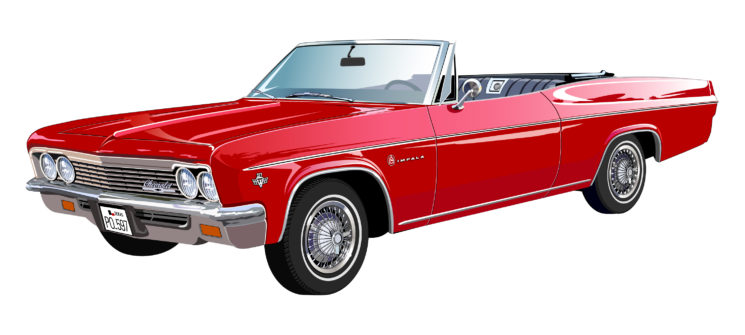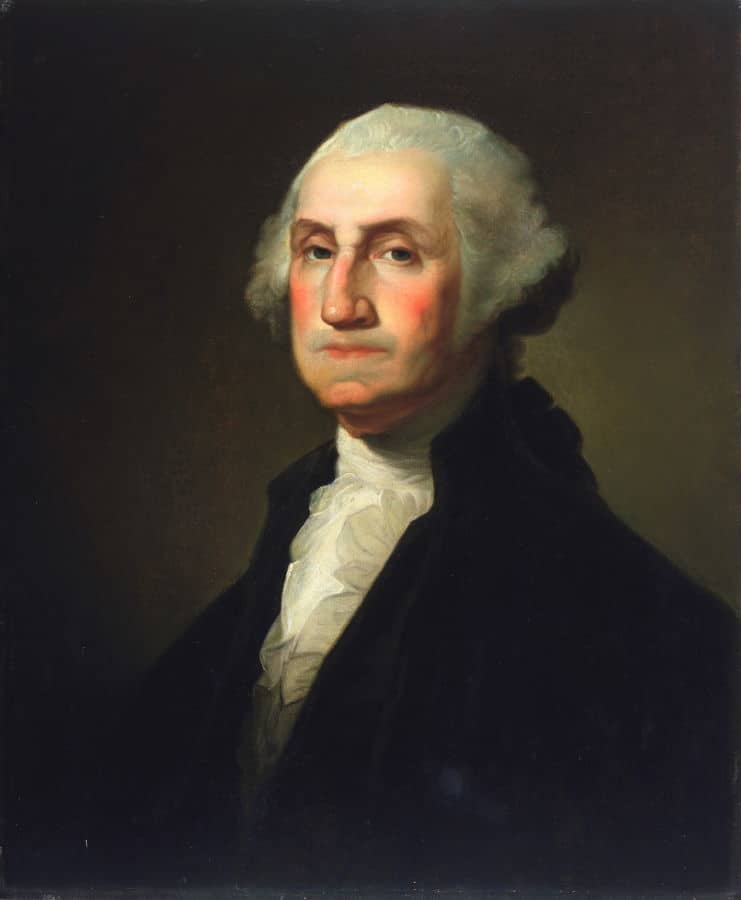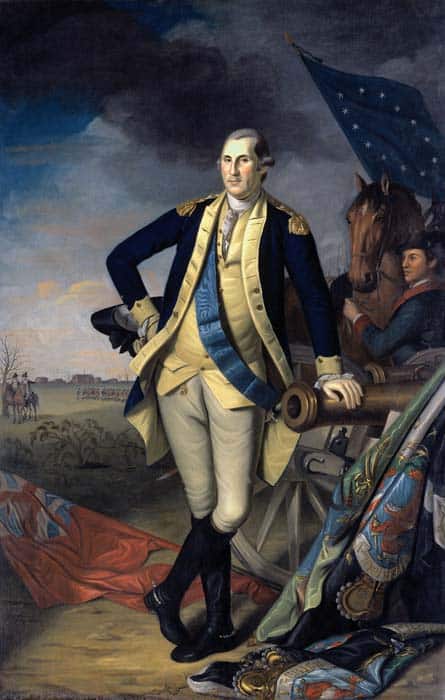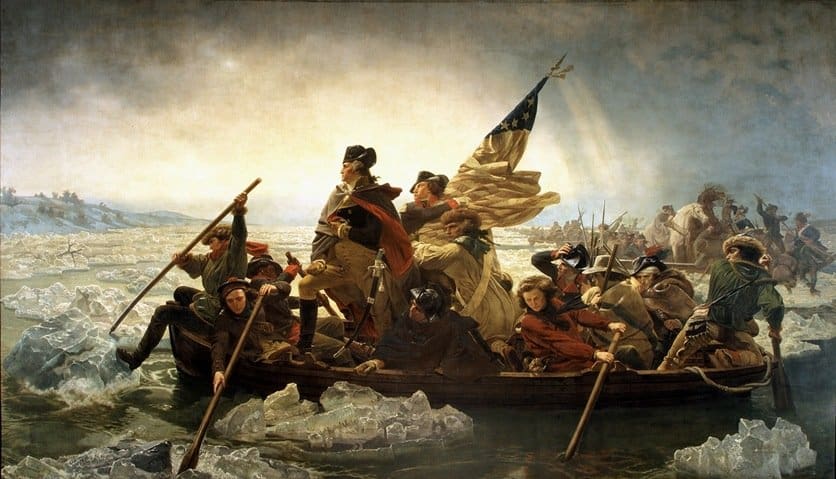Big Red Car here on a slightly gloomy President’s Day in the ATX. Ahh, it is still sweet. You can just begin to see the advent of spring.
So, today is President’s Day and one of the Presidents being honored is George Washington, our first President and Father of our Country.
With the passage of time, it becomes more and more evident what an extraordinary man he was and what extraordinary work he did. [Can you name a single politician today who could hold this guy’s horse? I can’t.]
Washington the Commander in Chief and President
While much is known of Washington’s life as the Commander in Chief of the Continental Army (huge startup success) and ultimately President of the United States, not very much has been written about his exploits until he attained those positions. The picture of the elderly man above is what America has in its minds eye of Washington, our first President.
Washington was 43 years old when he accepted the call of his countrymen to form an army to lead the colonial rebellion against the British. Life expectancy in the Colonies was less than 40 years at that time. Washington would live to be 67 years old.
Here is the famous Peale portrait of Washington painted after the end of the Revolution, a man in his early 50s but a robust man who had commanded an army in the field for a long time and had campaigned vigorously to defeat the most powerful army in the world.
Washington had lived a good life until then. He had been prepared for success by his entrepreneurial endeavors.
Washington the entrepreneurial surveyor and land developer
By age 16 — remember life expectancy was less than 40 years old — Washington had taken up the trade of surveying as a means of creating income to purchase land. All of his life, he would be a land developer and speculator.
He learned to survey and to draw plats of land — subdivision we would call it today.
As the frontier pressed ever westward, the King would grant land ownership to individuals and companies — sometimes deputizing his representatives in the Colonies to do this for him. This original ownership by royal grant was the beginning of the chain of title that would ultimately become the land ownership system in the United States until today. Many titles trace their origin to these original land grants.
These land grants were “patented” by creating a survey which identified these lands with a metes and bounds descriptions. This land patent was then filed of record and the chain of title had its first link. This is what Washington did at age 16.
The land grantees would then further subdivide their large land grants into smaller plots of farm land, timber land and sell them off to others. Washington would make these drawings, superimpose the surveys on the ground by marking trees and file these records also. This was the land development business in the colonies and how the King forced settlement to move ever westward.
Washington — who had inherited a bit of wealth from his father — used almost all of his surveying earnings to buy land. He also sought out patents. He received and bought approximately 20,000 acres of land for his service in the French and Indian War (called the Seven Years War on the European continent).
Washington would also add value by acquiring timber land, logging it and then clearing it for farmland. He bought swamp land and constructed canals to drain the swamps and to create extremely fertile farmland.
Washington the young officer
Washington had been named the military adjutant of a big section of Virginia and had raised a regiment — the Virginia Regiment — to fight in the French and Indian War. He was appointed the Colonel of that regiment. Quite an attainment for such a young man.
A little known fact is that Washington actually struck the first blow against the French in North America and was arguably the man who started the French and Indian War in North America.
By the age of 25, he had learned how to raise an army and to train it and to campaign it. He was very cool under fire but from a purely military perspective this was not a hugely successful undertaking other than the personal training and development of Washington. Perhaps the most important thing he learned had to do with the capabilities of militia troops v regulars and the logistics of supporting an army in combat a long way from their support base. These lessons would be critical to his success in the Revolution.
He was rewarded for his service in the French and Indian War and his command of the Virginia Regiment with a grant of 15,000 acres. He subsequently purchased other wartime grants and accumulated a total of approximately 20,000 acres bringing his holdings to approximately 25,000 acres at the time of the Revolution.
He was a very successful land developer and speculator.
Washington the farmer
Washington held much of his land in the form of operating plantations and farms. He had substantial plantations and farms through inheritance and marriage.
He had tenant farmers who grew tobacco on a “share” basis. He himself grew tobacco, wheat and other crops.
As a grower of wheat, he quickly learned of the additional value of milling one’s wheat into flour. He quickly vertically integrated this milling process and wheat became an excellent cash crop.
His plantations raised cows, pigs, horses and other farm animals.
While Washington routinely imported goods from England, he had an eye on self-sufficiency and when the British taxation issues that lead to the American Revolution were visited upon the Colonies, Washington was able to insulate his enterprises from the necessity to depend on imports.
Washington’s plantations also felled timber and operated a saw mill. He quarried stone for building projects. He built a schooner for both lumber transport, general shipping on the Colonial coast and for fishing. He had a considerable fishing operation which salted fish and exported it to the Caribbean.
Washington the slave owner
Slavery was a repugnant reality of Washington’s times and Washington was a substantial slave owner. Slavery is such an abhorrent and horrific degradation of humanity as to make the Big Red Car choke. It is nothing to be proud of but it will be reported as it happened. Ugh!
Washington owned slaves as a means of working his plantations and to leverage their labor to create value. He was a man of his times.
He is noted for having a man servant who was a slave and who was at his side for his entire life. If you look very closely at the famous Washington Crossing the Delaware picture, you can see his man servant directly behind Washington.
Washington was no more enlightened than other slave owners. He was however insistent upon his slaves being trained as craftsmen — brickmakers, bricklayers, carpenters, painters, fishers, sawyers, quarrymen — and artisans as they could then assist in the building process. This was not a common practice in those days.
Washington said that his experience with the ownership, care and feeding of his slaves was instrumental in his ability to raise, train and sustain an army.
Washington the financier
Washington had a great head for numbers and understood finance as it existed in colonial times. He made careful use of appropriate debt and “factored” his crops with a firm in England. He constantly used leverage to allow him to operate with a bit of long term vision. When he saw the unhappiness brewing with England, he slowly paid off his debts in England.
Washington leveraged the value of his land by using tenant farmers on a share basis. He bore the risks of the crop and got a bigger share as a result.
He sold land on credit. He managed those credit arrangements. He was a willing lender and while he was attentive to his affairs, there is no evidence that he ever pressed harder for payment than his debtor could realistically perform. He was very pragmatic.
Washington the administrator
Washington was a man who rose early in order to manage his accounts. While he used overseers to run his plantations, he often kept the books for his plantations, real estate and household. At any given time, he knew his financial position accurately.
As the Commander in Chief and the startup CEO of the Continental Army this propensity for precise paperwork and keeping it straight by simply working his ass off would contribute to his ability to manage such a huge enterprise. He was an extraordinary administrator.
He was a networker before the advent of LinkedIn and he was a relentless correspondent — no email in those days, ya’ll. His writings provide an insight into his brain and soul. While he was never a natural orator — remember you had Patrick Henry around in those days — he was an excellent writer. He wrote with clarity, sincerity and emotion.
Washington the politician
Washington was elected and appointed to high office. He routinely stood for and was elected to the House of Burgesses of Virginia. Every time the Royal Governor got poked by King George, the House of Burgesses was disbanded and had to stand for re-election as a means of the King and the Governor expressing their displeasure.
The Continental Congress was an outgrowth of the Colonial legislative bodies coming together because they had been individually disbanded.
One does not think of Washington as an elected political leader but he was, in fact, quite adept at campaigning and getting elected. Even as a fairly young man, his personal qualities were obvious and he was a natural leader. He never lost an election.
He was not a particularly impressive legislator and his speaking skills were not noteworthy. What was noteworthy was his enormous confidence, goodness and excellent judgment. He was close mouthed but no major decision was ever made without finding his position on the matter.
Washington the risk taker
Your friends will remark upon your ambition. Your detractors will see avariciousness in the same glance. Washington was ambitious and was prepared to work to attain his ends. He was not without his detractors.
His willingness to go into the Indian infested frontier to survey, his purchase of unproved but promising land tracts, his military exploits, his willingness to enter the political process, his fishing ventures based on building a schooner, his startup enterprises in milling — all paint a picture of a man who was willing to take measured risks to achieve his desired objectives.
At the beginning of the Revolution, Washington was one of the wealthiest men in the Colonies. This willingness to risk his wealth was an inspiration to others. If this man would risk all that he had and had built, how could other rebels risk less? There is no evidence that Washington ever took counsel of his fears. He was supremely confident and had been prepared for this challenge by his 43 years of risk taking.
In his military exploits this risk taking took the form of daring which informed his strategy at critical junctions in the war. Washington’s decision to attack Trenton — perhaps the critical battle of the Revolution which showed the world that the Continentals could hang with and bloody the British regulars and their mercenaries — in a complex nighttime amphibious double envelopment stands as one of the greatest feats of arms in the history of warfare.
Washington was a guy who could stare a risk down and make it roll over and ask for its Momma.
Washington the stud
Washington had the gift of physical presence. He was taller than six feet and was a robust looking young man.
He was often spoken of as the best horseman in North America — WOW! The best damn horseman in a society in which the only means of transportation was a horse between your legs.
In several battles — enroute to Princeton from Trenton as an example — he would routinely jump fences and arrive at the critical point of attack on horseback. This was a skill that was not possessed by many other general officers of that war. The propensity and ability of Washington to be at the point of attack and to personally influence the outcome was the hallmark of his leadership.
Washington traveled well and thought nothing of spending a month or two on the frontier chasing a land deal or reconning a new real estate opportunity. He traveled to the islands when his brother was taken ill.
He married the most desirable (and richest) woman in the Colonies and kept her in a splendor that was royal.
All of the above is intended to let us know the man who at age 43 would create a pretty damn good startup — the United States of America. From that point in history forward, it is easy to find examples of his goodness, integrity, brilliance, leadership, management and other personal traits that propelled him and the United States forward. He could have been our King had he only nodded when asked.
So where did all that goodness and talent come from? It came from his entrepreneurial endeavors as a young man and the preparation such endeavors provided for his later success. America was created by an American entrepreneur — just like you, Old Sport. Just like you.
So get out there and bite the ass off a bear, entrepreneur genius.
Bit of homework for you? Go read:
George Washington, America’s First Entrepreneur and Startup Genius
George Washington – The Ultimate Crisis Leader
But, hey, what the Hell do I really know anyway? I’m just a Big Red Car. [Bonus question — what was George Washington’s middle name?]




.
Happy President’s Day. Today we celebrate George Washington. Here is some stuff you need to know about the Father of Our Country and our First President.
https://themusingsofthebigredcar.com/george-washington-america/
Read it.
BRC
https://www.themusingsofthebigredcar.com
#washington #georgewashington #presidentsday